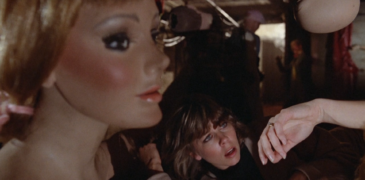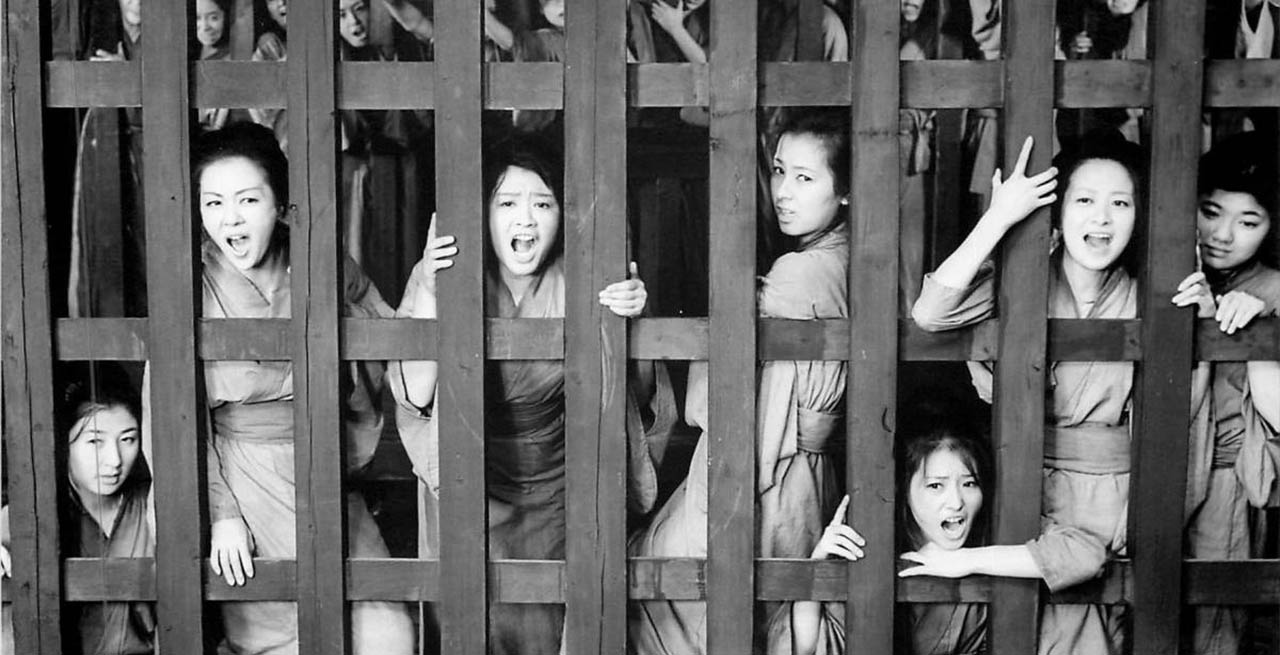
Despite being one of Japan’s biggest film studios throughout the late 40s and 50s during the golden age of Japanese cinema, Daiei was struggling by the mid-60s and had to slash budgets for their productions. This eventually led to a merger with Nikkatsu in 1970, followed by bankruptcy in 1971. Somewhat overlooked is Daiei’s 1968-1969 period where they started to focus on exploitation films and could be considered as their own equivalent to “pinky violence“. This era of exploitation, dubbed by Daiei as their “ero guro/unique historical drama” line, is largely defined by two film series: the Woman’s Secret series and the Kanto Woman series. After exploring historical brothels with Secrets of a House of Women, the Woman’s Secret series returned to its origins for the third entry with a follow-up to Secrets of a Woman’s Prison. Despite being titled as a sequel, Secrets of a Woman’s Prison 2 is a totally new story and shares little with its predecessor, other than the setting of an Edo-era prison.
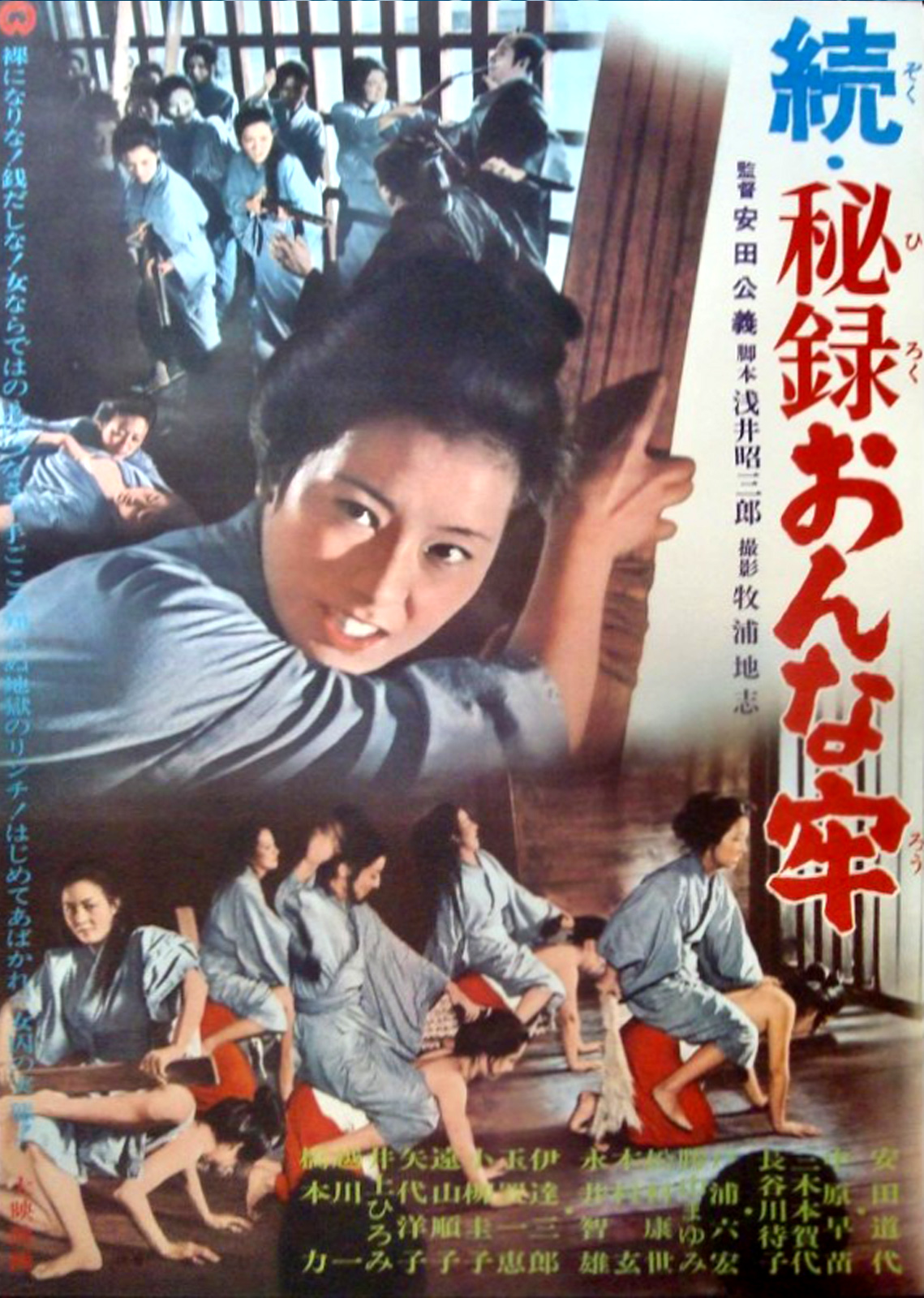

Because of how obscure this film is, Rob has outlined the plot below. If you want to avoid spoilers, skip down to the “Spoilers end here” tag below.
Secrets of a Woman’s Prison 2 opens with a shot of a frosty prison yard with an ominous pit lying at the centre. We then see a female prisoner with a sack over her head forced to her knees in front of the pit, before she is decapitated in full view of her fellow prisoners who are forced to sit and watch. After the grisly opening, we follow a young prisoner named Onami (Michiyo Yasuda). Despite her youth, Onami has a fiery spirit and her unwillingness to submit to neither her fellow prisoners nor the guards, makes her stand out amongst the rest of the prison population. When the cruel prison officer Senzo (Rokuhiro Toura) finds a sack of money that has been stashed away in the women’s cell, the prisoners are forced out into the yard and made to crawl in circles like cattle as Senzo goes around whipping each of them with sadistic glee until he gets a confession. When he is met with silence he figures the rebellious Onami will make a fine scapegoat and he relishes the opportunity to take out his resentment on her at long last.
Following this, Onami must endure seemingly endless torture at the hand of Senzo as he regularly strings her up to beat, whip, cut, and stab her. Life in the cell also becomes difficult and despite the strict hierarchy of prisoners – with Oseki (Miki Honga) at the top keeping firm but fair control – frustrations between the inmates quickly reach boiling point. Among the scores of women forced to occupy the single cell is Otama (Mayumi Katsuyama), a nymphomaniac who is often found attempting to molest her cellmates in the dead of night. With the collective guilt over the torture of Onami weighing on everyone’s minds, Otama eventually pushes her luck too far and she is seized and strapped upside-down on the bars before being taunted and humiliated. Senzo comes to her rescue but in return demands her body as payment for his kindness; Otama is all too happy to comply and soon becomes his secret mistress. Senzo, seeing an opportunity, offers the same deal to Onami in exchange for ending her torture, but she refuses. As a result, her torture becomes even more intense, leaving her borderline crippled and forced to wear handcuffs 24/7. Senzo’s behaviour quickly becomes more severe and when one prisoner is about to be released after serving her four-year sentence, he bribes the prison doctor to give her poison on the last night before her release.
After realising the extent of Senzo’s crimes, Onami takes the lead and unites her cellmates for a desperate escape attempt, fearing that any one of them could be next. However, Otama, after her treatment by the other prisoners, harbours no loyalty and quickly leaks the news of a potential breakout to Senzo during one of their midnight trysts. Incensed with rage, he immediately searches the cell for tools and forces the prisoners out into the yard in the dead of night during a howling snowstorm. Each prisoner is savagely beaten one by one in an effort to find the mastermind behind the plan, but they stand together in solidarity. Upon returning to the cell, Otama is found dead in the corner and it is revealed that she was killed at the hands of Oseki after discovering that she was the traitor. This provides the prisoners an opportunity for their escape and they trick Senzo and the doctor to enter the cell in order to examine the body. As soon as they step in, they are quickly overpowered and tied up. The prisoners then storm through the prison with their hostage, first raiding the armoury for swords and guns, before entering the yard demanding release. When the prison magistrate is summoned, the prisoners explain the extent of Senzo’s crimes to him and he graciously offers to overlook this escape attempt and even pardons Onami.
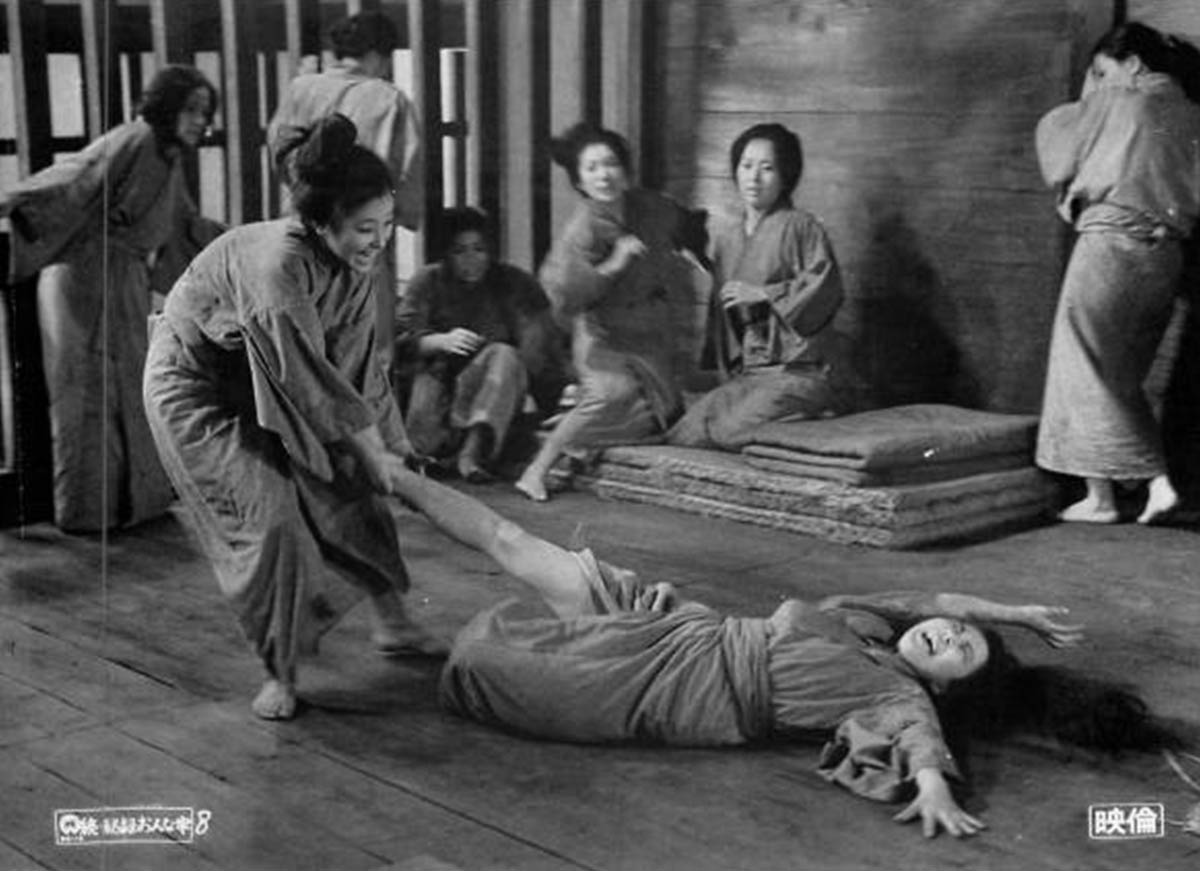
At first glance, Secrets of a Woman’s Prison 2 is a far more simplistic film than its predecessor, although it is all the better for it. Instead of worrying about overly complex backstories and wrongly arrested prisoners, Secrets of a Woman’s Prison 2 keeps its focus firmly within the prison walls. This pared-down approach allows the prison setting to flourish and the character drama to occur naturally – something which Secrets of a Woman’s Prison failed to achieve. Whilst in Secrets of a Woman’s Prison, constant infighting between prisoners provided the main source of drama and action within the cell, Secrets of a Woman’s Prison 2 opts for the opposite approach. Cell life is relatively harmonious which shifts the role of antagonist away from the other female prisoners and onto the male prison establishment.
By allowing the women to take a united stand against their cruel, patriarchal prison masters, the film achieves a great sense of community and sisterhood, demonstrating the unstoppable strength of the women’s spirits when they come together. Unfortunately, this is quickly undone by the bizarre finale. Surrounded but not outgunned by guards in the prison yard, it seems that a violent uprising is imminent in the stalemate. However, with the appearance of the magistrate, the power of the preceding events is quickly undone as Onami literally kneels before him in apparent subservience and thanks him for his charity. For a film which, until this point, had such a strong feminist message building up, it is certainly a kick in the teeth even if the prisoners do get justice for Senzo’s actions.
End of Spoilers
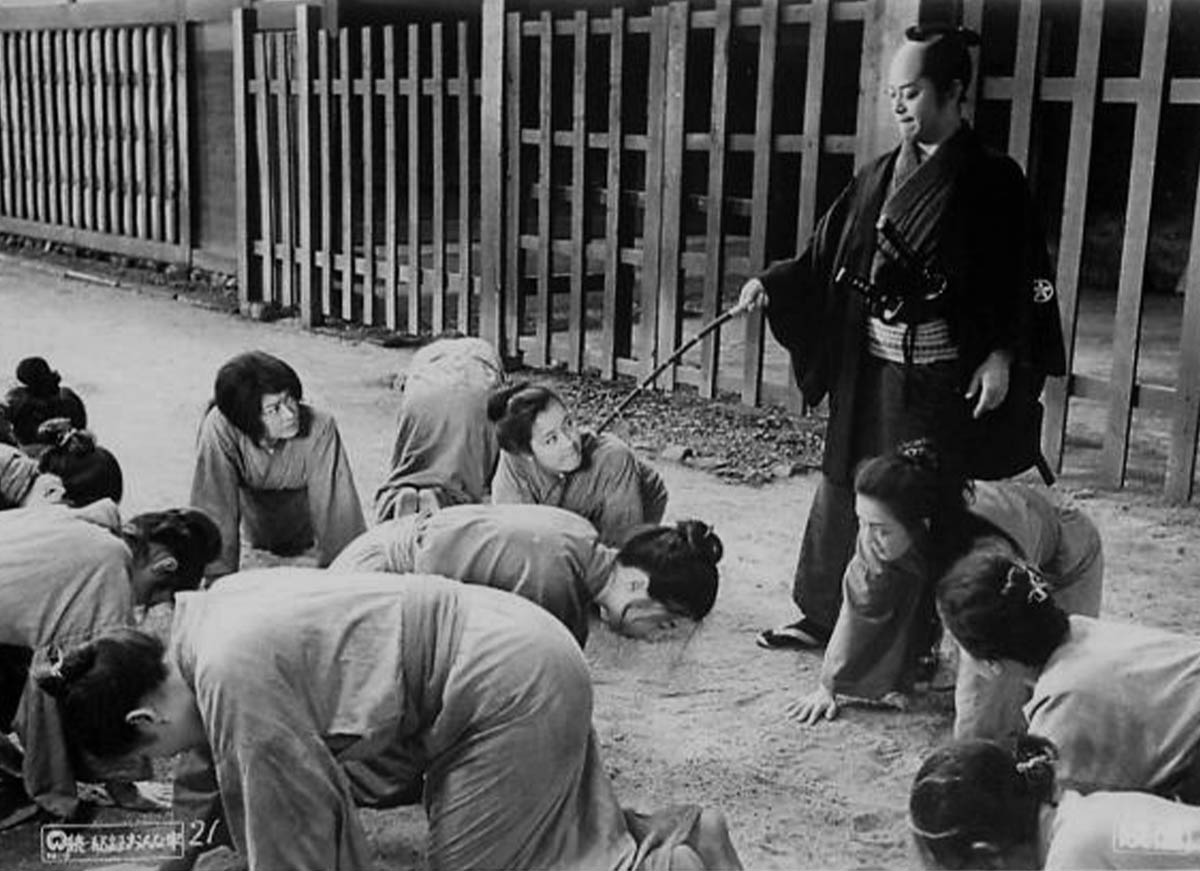
Something else missing from Secrets of a Woman’s Prison was brutality. As mentioned in our previous review, being the first of Daiei’s exploitation films, and also one of the first films in the women-in-prison genre, gauging audience expectations would have been difficult. As it stood, the film was quickly outdone by Teruo Ishii’s controversial examination of similar themes just a few months later with Shogun’s Joy of Torture. As a sequel, Secrets of a Woman’s Prison 2 brings with it a new focus on torture and punishment. Despite the number of torture scenes, the film never strays into torture porn like many of the more reductive exploitation films that would follow in the 1970s from the likes of Toei and Nikkatsu. Director Kimiyoshi Yasuda treads the line of taste to great effect, allowing for truly horrifying scenes without the need to descend into overt explicitness. With quick, disorientating cuts and a cacophonous distorted guitar screaming forth, the scenes are an assault on the viewer’s senses. Complemented by borderline psychedelic image manipulation which brings to mind the rending of flesh, it is left to the viewer’s own imagination to fill in the gaps of Onami’s suffering, proving that the abstract can be far more disturbing than cold realism.
That is not to say that Secrets of a Woman’s Prison 2 shies away from brutality. One extended scene focuses on a particularly nasty Japanese method of torture called “ishidaki” or “stone holding”: the victim is forced to kneel on a board of jagged wooden spikes, then giant stone tablets are slowly stacked on top of their thighs one after the other. Throughout the scene, the camera remains still, not allowing the viewer to look away and is totally void of music. At its crescendo, Senzo viciously stamps his foot on top of the three stones already crushing Onami’s thighs, bringing forth a truly blood-curdling screech of agony.
For this sequel, Kimiyoshi Yasuda takes over the director’s seat from Akira Inoue. Both directors have their own styles and it is admittedly hard not to compare their differing approaches to the prison setting. Whilst Inoue shone with his interior shots, going to great lengths to highlight the claustrophobic and cramped conditions of the cell, Yasuda feels a lot more clinical in this setting. Nevertheless, where his skill truly comes through are the exterior shots. With the harsh wintry prison accompanied by the foreboding execution pit ever present in the main yard, his imagery is disturbingly serene which further highlights the extent of the human cruelty present. Through his subtle use of blocking he wordlessly invokes conflict, separating his characters to show the imbalance of power and emotions; this show-and-not-tell approach keeps the script tight and expositional dialogue to a minimum. As an example, the viewer can see quite early on that Otama is a potential threat purely from the position that she is shown standing in compared to the other prisoners – always just off frame, her ear pricked up as she is no doubt cussing her fellow prisoners in her mind.
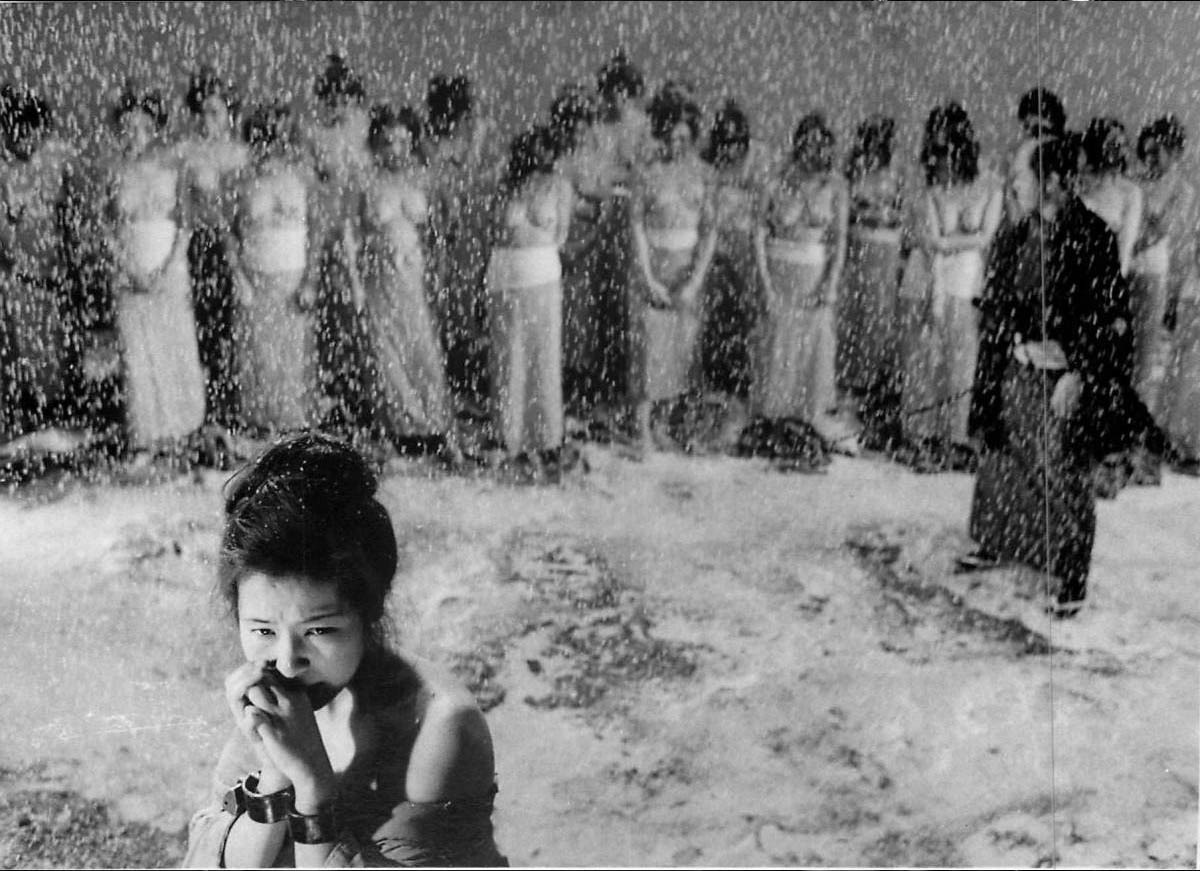
In contrast to her roles in the prior two films of the Woman’s Secret series which built on Michiyo Yasuda’s history as a youth actress and had her playing vulnerable and naïve characters, Secrets of a Woman’s Prison 2 finally allows her to stretch her legs in a more dominant role. Onami’s strength earns her respect from both her fellow prisoners and the audience and shows that despite her treatment at the hands of Senzo, she is still very capable. This dynamic leaves the audience wondering not whether she will survive her treatment, but instead wondering just when she will seize the opportunity to fight back. As Onami, Yasuda stays true to her character’s fortitude and always maintains that rebellious nature in her sharp gaze, no matter how battered and broken her body may be.
Starring opposite her, Rokuhiro Toura is the perfect villain for the film. He makes sure the audience can see how much delight the torture of prisoners provides the sadistic Senzo but still keeps his character measured and believable. The most chilling characteristic isn’t Senzo’s bloodthirsty brutality, nor his skill as a manipulator – it is his calm arrogance. A man in his position is dangerous enough as it is, but with his certainty that he will never be caught out, he allows himself to indulge in ever more extreme acts of savagery as his darkest fantasies become unshackled. A much smaller yet important part comes courtesy of Mayumi Katsuyama as the snidey Otama. It is a part with few lines and little direct presence, but she always ensures that the audience knows that she is up to something. Her surreptitious glares and microaggressions quickly reveal to the viewers how much she despises Onami, and even without the scenes showing her molesting her cellmates, she still comes across as extremely hateful.
Correcting course on many of the missteps of its predecessor, Secrets of a Woman’s Prison 2 offers a more worthy examination of the unique historical prison setting. With a tought and focused plot, the film admirably shows the strength of its characters in the face of adversity. Offering an uncomfortably intimate look at Edo-era torture, the film is unflinching in its portrayal of brutality, yet still treats its female characters with the respect that they deserve. Ultimately falling at the last hurdle with a severely misjudged ending, Secrets of a Woman’s Prison 2 narrowly misses being a classic of the women-in-prison genre but still achieves a broadly feminist overview that few of its contemporaries achieved.
More Film Reviews
Eldorado (2022) Film Review – Roadtrip!
Eldorado is a 2022 extreme road movie written by Andrea Cavaletto, and directed by Domiziano Christopharo. Not the first time working together, Andrea and Domiziano have collaborated on a number…
Dagr (2024) Film Review – Found Footage Folk Horror That Slaps
Dagr (2024), by director Matthew Butler-Hart and produced by Fizz & Ginger Films, is the perfect found footage film: a labour of love from a small but incredibly talented creative…
Deadly Games (1982) Film Review – Low-Key Slasher That Slipped Under the Radar
If you ask a casual movie goer to list some classic horror films, a large majority of them will mention Halloween, Friday the 13th, and The Texas Chainsaw Massacre. One…
Cosmic Dawn (2022) Film Review – Drink the Canadian Kool-Aid!
Cosmic Dawn is one of those films that is difficult to summarize, wherein the plot is not nearly as important as the experience. Furthermore, the production fluctuates between amateurism and…
Ceroboh (2022) Film Review – The Real Sky Beast is Man
Ceroboh (aka The Screaming Sky) is a 2022 Malaysian sci-fi thriller, directed by Feisal Azizuddin. Mostly known for directing shorts, Feisal made his move into feature-length directing the drama thriller…
We’re All Going to the World’s Fair (2021) Film Review – Getting Lost Online
A lonely and awkward teen joins a viral internet fad called The World’s Fair Challenge, said to potentially change you mentally and physically. After taking the challenge she begins to…

Hi, I have a borderline obsession with Japanese showa-era culture with much of my free time spent either consuming or researching said culture. Apparently I’m now writing about it as well to share all the useless knowledge I have acquired after countless hours surfing the web and peeling through books and magazines.


